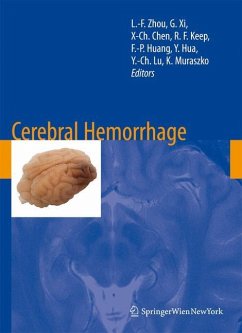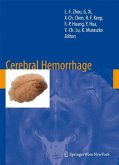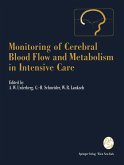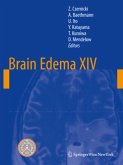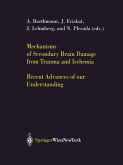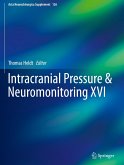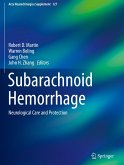Cerebral Hemorrhage
Herausgegeben:Zhou, Liang-Fu; Xi, Guohua; Chen, Xian-Cheng; Keep, Richard F.; Huang, Feng-Ping; Hua, Ya; Lu, Yi-Cheng; Muraszko, Karin
Cerebral Hemorrhage
Herausgegeben:Zhou, Liang-Fu; Xi, Guohua; Chen, Xian-Cheng; Keep, Richard F.; Huang, Feng-Ping; Hua, Ya; Lu, Yi-Cheng; Muraszko, Karin
- Gebundenes Buch
- Merkliste
- Auf die Merkliste
- Bewerten Bewerten
- Teilen
- Produkt teilen
- Produkterinnerung
- Produkterinnerung
Cerebral hemorrhage is a common and often fatal subtype of stroke. while in the past it has received relatively little attention compared to ischemic stroke, there have been major advances in our understanding of this devastating form of stroke. The papers by world experts cover the field from molecular biology to clinical trials.
Andere Kunden interessierten sich auch für
![Cerebral Hemorrhage Cerebral Hemorrhage]() Cerebral Hemorrhage149,99 €
Cerebral Hemorrhage149,99 €![Monitoring of Cerebral Blood Flow and Metabolism in Intensive Care Monitoring of Cerebral Blood Flow and Metabolism in Intensive Care]() Monitoring of Cerebral Blood Flow and Metabolism in Intensive Care39,99 €
Monitoring of Cerebral Blood Flow and Metabolism in Intensive Care39,99 €![Brain Edema XIV Brain Edema XIV]() Zbigniew Czernicki / Alexander Baethmann / Umeo et al. Ito (Hrsg.)Brain Edema XIV150,99 €
Zbigniew Czernicki / Alexander Baethmann / Umeo et al. Ito (Hrsg.)Brain Edema XIV150,99 €![Mechanisms of Secondary Brain Damage from Trauma and Ischemia Mechanisms of Secondary Brain Damage from Trauma and Ischemia]() Alexander Baethmann / Jörg Eriskat / Jens Lehmberg / Nikolaus Plesnila (eds.)Mechanisms of Secondary Brain Damage from Trauma and Ischemia115,99 €
Alexander Baethmann / Jörg Eriskat / Jens Lehmberg / Nikolaus Plesnila (eds.)Mechanisms of Secondary Brain Damage from Trauma and Ischemia115,99 €![Intracranial Pressure & Neuromonitoring XVI Intracranial Pressure & Neuromonitoring XVI]() Intracranial Pressure & Neuromonitoring XVI172,99 €
Intracranial Pressure & Neuromonitoring XVI172,99 €![Subarachnoid Hemorrhage Subarachnoid Hemorrhage]() Subarachnoid Hemorrhage104,99 €
Subarachnoid Hemorrhage104,99 €![Neuropsychological Sequelae of Subarachnoid Hemorrhage and its Treatment Neuropsychological Sequelae of Subarachnoid Hemorrhage and its Treatment]() B.O. HütterNeuropsychological Sequelae of Subarachnoid Hemorrhage and its Treatment77,99 €
B.O. HütterNeuropsychological Sequelae of Subarachnoid Hemorrhage and its Treatment77,99 €-
-
-
Cerebral hemorrhage is a common and often fatal subtype of stroke. while in the past it has received relatively little attention compared to ischemic stroke, there have been major advances in our understanding of this devastating form of stroke. The papers by world experts cover the field from molecular biology to clinical trials.
Produktdetails
- Produktdetails
- Acta Neurochirurgica Supplement 105
- Verlag: Springer / Springer Vienna / Springer, Wien
- Artikelnr. des Verlages: 11976097, 978-3-211-09468-6
- 2008
- Seitenzahl: 260
- Erscheinungstermin: 12. November 2008
- Englisch
- Abmessung: 285mm x 215mm x 21mm
- Gewicht: 803g
- ISBN-13: 9783211094686
- ISBN-10: 3211094687
- Artikelnr.: 24770900
- Herstellerkennzeichnung
- Springer-Verlag KG
- Sachsenplatz 4-6
- 1201 Wien, AT
- ProductSafety@springernature.com
- Acta Neurochirurgica Supplement 105
- Verlag: Springer / Springer Vienna / Springer, Wien
- Artikelnr. des Verlages: 11976097, 978-3-211-09468-6
- 2008
- Seitenzahl: 260
- Erscheinungstermin: 12. November 2008
- Englisch
- Abmessung: 285mm x 215mm x 21mm
- Gewicht: 803g
- ISBN-13: 9783211094686
- ISBN-10: 3211094687
- Artikelnr.: 24770900
- Herstellerkennzeichnung
- Springer-Verlag KG
- Sachsenplatz 4-6
- 1201 Wien, AT
- ProductSafety@springernature.com
Experimental intracerebral hemorrhage - iron, hemoglobin and free radicals.- Deferoxamine therapy for intracerebral hemorrhage.- Bilirubin oxidation products, oxidative stress, and intracerebral hemorrhage.- Deferoxamine reduces brain swelling in a rat model of hippocampal intracerebral hemorrhage.- The antioxidant effects of melatonin after intracerebral hemorrhage in rats.- Poly(ADP-ribose) polymerase activation and brain edema formation by hemoglobin after intracerebral hemorrhage in rats.- Induction of autophagy in rat hippocampus and cultured neurons by iron.- Effects of superoxide dismutase and catalase derivates on intracerebral hemorrhage-induced brain injury in rats.- Metallothionein and brain injury after intracerebral hemorrhage.- Experimental intracerebral hemorrhage - inflammation and thrombin.- Intracerebral hemorrhage injury mechanisms: glutamate neurotoxicity, thrombin, and Src.- Increase in brain thrombin activity after experimental intracerebral hemorrhage.- Microglial activation and intracerebral hemorrhage.- Concomitant intracerebral infusion of tissue plasminogen activator and thrombin leads to brain injury.- Microglial activation and brain injury after intracerebral hemorrhage.- Effects of aging on complement activation and neutrophil infiltration after intracerebral hemorrhage.- Experimental intracerebral hemorrhage - other mechanisms.- Blood-brain barrier function in intracerebral hemorrhage.- Treatment of stroke and intracerebral hemorrhage with cellular and pharmacological restorative therapies.- Deficiency of CD18 gene reduces brain edema in experimental intracerebral hemorrhage in mice.- Tissue inhibitor of matrix metalloproteinases-3 (TIMP-3) lacks involvement in bacterial collagenase-induced intracerebral hemorrhage in mouse.- Radialglia marker expression following experimental intracerebral hemorrhage.- Long-term effects of melatonin after intracerebral hemorrhage in rats.- Management of delayed edema formation after fibrinolytic therapy for intracerebral hematomas: preliminary experimental data.- Erythropoietin attenuates intracerebral hemorrhage by diminishing matrix metalloproteinases and maintaining blood-brain barrier integrity in mice.- Hyperbaric oxygen for experimental intracerebral hemorrhage.- Effect of amantadine sulphate on intracerebral hemorrhage-induced brain injury in rats.- Experimental intracerebral hemorrhage - model development and characterization.- Long-term behavioral characterization of a rat model of intracerebral hemorrhage.- Neurological deficits and brain edema after intracerebral hemorrhage in Mongolian gerbils.- Rat model of intracerebellar hemorrhage.- A rat model of pontine hemorrhage.- Human intracerebral hemorrhage.- The optimal time-window for surgical treatment of spontaneous intracerebral hemorrhage: result of prospective randomized controlled trial of 500 cases.- Preliminary findings of the minimally-invasive surgery plus rtPA for intracerebral hemorrhage evacuation (MISTIE) clinical trial.- Pediatric cerebrovascular diseases: report of 204 cases.- Xenon-CT study of regional cerebral blood flow around hematoma in patients with basal ganglia hemorrhage.- Preliminary application of pyramidal tractography in evaluating prognosis of patients with hypertensive intracerebral hemorrhage.- Experimental intracranial hemorrhage (non-intracerebral hemorrhage).- Mechanisms and markers for hemorrhagic transformation after stroke.- The clinical significance of acute brain injury in subarachnoid hemorrhage and opportunity for intervention.- Development of a cerebralmicrovascular dysplasia model in rodents.- Hyperbaric oxygen preconditioning protects against traumatic brain injury at high altitude.- Human intracranial hemorrhage (non-intracerebral hemorrhage).- Genetic considerations relevant to intracranial hemorrhage and brain arteriovenous malformations.- Vasospasm after aneurysmal subarachnoid hemorrhage: need for further study.- Regional cerebral blood flow and oxygen metabolism in aneurysmal subarachnoid hemorrhage: positron emission tomography evaluation of clipping versus coiling.- Preliminary report of the clot lysis evaluating accelerated resolution of intraventricular hemorrhage (CLEAR-IVH) clinical trial.- Leptin plays a role in ruptured human brain arteriovenous malformations.- Novel treatments for cerebral vasospasm following aneurysmal subarachnoid hemorrhage.- Relationship between serum sodium level and brain ventricle size after aneurysmal subarachnoid hemorrhage.- Lack of association between apolipoprotein E promoters in 4? carriers and worsening on computed tomography in early stage of traumatic brain injury.
Experimental intracerebral hemorrhage - iron, hemoglobin and free radicals.- Deferoxamine therapy for intracerebral hemorrhage.- Bilirubin oxidation products, oxidative stress, and intracerebral hemorrhage.- Deferoxamine reduces brain swelling in a rat model of hippocampal intracerebral hemorrhage.- The antioxidant effects of melatonin after intracerebral hemorrhage in rats.- Poly(ADP-ribose) polymerase activation and brain edema formation by hemoglobin after intracerebral hemorrhage in rats.- Induction of autophagy in rat hippocampus and cultured neurons by iron.- Effects of superoxide dismutase and catalase derivates on intracerebral hemorrhage-induced brain injury in rats.- Metallothionein and brain injury after intracerebral hemorrhage.- Experimental intracerebral hemorrhage - inflammation and thrombin.- Intracerebral hemorrhage injury mechanisms: glutamate neurotoxicity, thrombin, and Src.- Increase in brain thrombin activity after experimental intracerebral hemorrhage.- Microglial activation and intracerebral hemorrhage.- Concomitant intracerebral infusion of tissue plasminogen activator and thrombin leads to brain injury.- Microglial activation and brain injury after intracerebral hemorrhage.- Effects of aging on complement activation and neutrophil infiltration after intracerebral hemorrhage.- Experimental intracerebral hemorrhage - other mechanisms.- Blood-brain barrier function in intracerebral hemorrhage.- Treatment of stroke and intracerebral hemorrhage with cellular and pharmacological restorative therapies.- Deficiency of CD18 gene reduces brain edema in experimental intracerebral hemorrhage in mice.- Tissue inhibitor of matrix metalloproteinases-3 (TIMP-3) lacks involvement in bacterial collagenase-induced intracerebral hemorrhage in mouse.- Radialglia marker expression following experimental intracerebral hemorrhage.- Long-term effects of melatonin after intracerebral hemorrhage in rats.- Management of delayed edema formation after fibrinolytic therapy for intracerebral hematomas: preliminary experimental data.- Erythropoietin attenuates intracerebral hemorrhage by diminishing matrix metalloproteinases and maintaining blood-brain barrier integrity in mice.- Hyperbaric oxygen for experimental intracerebral hemorrhage.- Effect of amantadine sulphate on intracerebral hemorrhage-induced brain injury in rats.- Experimental intracerebral hemorrhage - model development and characterization.- Long-term behavioral characterization of a rat model of intracerebral hemorrhage.- Neurological deficits and brain edema after intracerebral hemorrhage in Mongolian gerbils.- Rat model of intracerebellar hemorrhage.- A rat model of pontine hemorrhage.- Human intracerebral hemorrhage.- The optimal time-window for surgical treatment of spontaneous intracerebral hemorrhage: result of prospective randomized controlled trial of 500 cases.- Preliminary findings of the minimally-invasive surgery plus rtPA for intracerebral hemorrhage evacuation (MISTIE) clinical trial.- Pediatric cerebrovascular diseases: report of 204 cases.- Xenon-CT study of regional cerebral blood flow around hematoma in patients with basal ganglia hemorrhage.- Preliminary application of pyramidal tractography in evaluating prognosis of patients with hypertensive intracerebral hemorrhage.- Experimental intracranial hemorrhage (non-intracerebral hemorrhage).- Mechanisms and markers for hemorrhagic transformation after stroke.- The clinical significance of acute brain injury in subarachnoid hemorrhage and opportunity for intervention.- Development of a cerebralmicrovascular dysplasia model in rodents.- Hyperbaric oxygen preconditioning protects against traumatic brain injury at high altitude.- Human intracranial hemorrhage (non-intracerebral hemorrhage).- Genetic considerations relevant to intracranial hemorrhage and brain arteriovenous malformations.- Vasospasm after aneurysmal subarachnoid hemorrhage: need for further study.- Regional cerebral blood flow and oxygen metabolism in aneurysmal subarachnoid hemorrhage: positron emission tomography evaluation of clipping versus coiling.- Preliminary report of the clot lysis evaluating accelerated resolution of intraventricular hemorrhage (CLEAR-IVH) clinical trial.- Leptin plays a role in ruptured human brain arteriovenous malformations.- Novel treatments for cerebral vasospasm following aneurysmal subarachnoid hemorrhage.- Relationship between serum sodium level and brain ventricle size after aneurysmal subarachnoid hemorrhage.- Lack of association between apolipoprotein E promoters in 4? carriers and worsening on computed tomography in early stage of traumatic brain injury.

